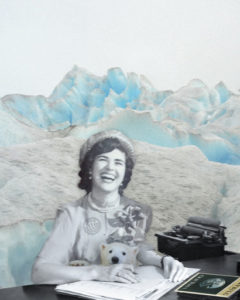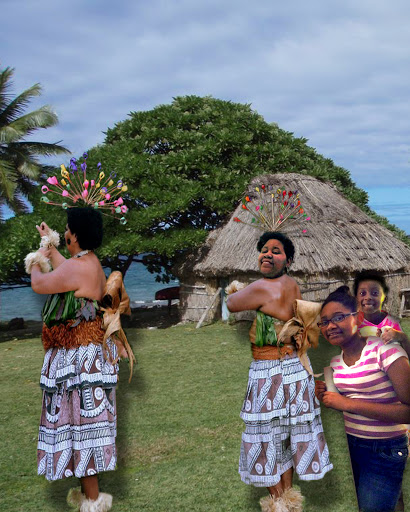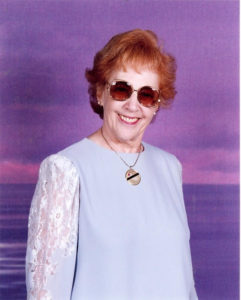Today SevenPonds concludes our conversation with Nancy Gershman, a memory artist who creates “Dreamscapes” for people in hospice and their families. A Dreamscape is a photo collage that serves as a physical image of a memory or something the ill/deceased person wanted to do but never had the chance to achieve. Nancy works with the Visiting Nurse Service of New York’s Haven Hospice.

Dreamscape of Phyllis re-envisioned at age 26 when her radio play about a polar bear was the talk of Ithaca.
Credit: artforyoursake.com
Lucas: As the person making the Dreamscape, what is the most important thing to consider while you’re creating one?
Nancy Gershman: If you’re the person creating the Dreamscape, the most important thing is to be genuinely curious. That opens doors, and it sounds so matter-of-fact, but it does make a difference. You also want to get people to be as detailed as possible because that helps to really light up the brain. For instance, if I am making a Dreamscape of a memory/event that actually happened and they tell me he was wearing shorts…what kind of shorts were they? Long or short? What color? And the more they think about the details, the less sad they tend to get.
Lucas: What are some methods you can employ to help people be detailed about their loved one and/or a specific memory?
Nancy: It’s vital to find out what a person’s passion was. So if I’m getting too generic of an answer, I may ask, “What could this person not live without?” Rewording is a good way to get more specific answers. There are also different kinds of positive memories that you can try to tap into. A positive memory doesn’t mean that everyone was always smiling and laughing. It could be something like the gentle touching of the hand or a certain gesture. It doesn’t have to be an event, per se.
Another important thing is to observe the interviewee when they’re describing their memory or loved one. They could be smiling but may also appear to be on the brink of sadness. From that, you may see if it’s possible to slightly alter that memory so that it will be a purely positive one that you will display in the Dreamscape. So you’re always observing their body and facial expressions. Also anything sensory that they might remember, anything to do with touch or smell, is important.
Lucas: What are some different kinds of memories/Dreamscapes you’ve recreated?
Nancy: I’ve had some families that have heard of what I do and know that they want something for the memorial service. Maybe the person wants something that the other brothers and sisters don’t have. So I’ll depict their special relationship, “quality time with Dad,” in a way

Dreamscape of Rita re-envisioned as an anti-smoking cop with husband Albert recast as a judge on their favorite cruise ship.
Credit: Artforyoursake.com
they never had before. I’ve worked with poor, underserved families who may not have had the luxury of owning a camera but had one disheveled photo of their loved one. And from that I’m able to create a fully fleshed-out story.
It also doesn’t need to be about one person. I’ve made Dreamscapes that recreate how a couple first met if they don’t have a photo of that. I also made a Dreamscape with a man whose father had died. His father was a lawyer who always wanted to be a judge but never got to be one. So we put his father in the robes and had him shaking his wife’s hand. We then put them on their favorite cruise ship. So there are many ways Dreamscapes can be utilized.
Lucas: We touched on this a bit, but how can you use Dreamscapes to help soothe a person who’s in hospice care?
Nancy: Some people have a really crazy fantasy that went through their mind that maybe they had never told anybody about. So you want to make them feel like they’re in a safe place so they can share that with you. I give them a chance to make it real and concrete. I will use both photos that I get from the family and ones that I get online. Sometimes I will photograph the patient and then use Photoshop to change their clothes.
Lucas: Have you noticed any overarching themes or similarities you’ve found between your subjects?
Nancy: As a matter of fact there are. It usually boils down to something so unbelievably simple. Dreamscapes and their memories are usually about love, pride or validation. People want to be seen and heard; they want to be loved, and they want their loved ones to be proud of them. Almost everything gets reduced to that.
Lucas: How long does it take you to create a Dreamscape?
Nancy: The physical creation will take me a couple hours, but the assembly is not the hardest part. The hardest part is deciding whether I have all the images I need, and searching for images I don’t have. Then it goes to the family and I wait for their feedback. They might want to take out an element or add something else. They usually have a rough idea of what I will do, but not completely.
Lucas: What do you enjoy most about making Dreamscapes?

Dreamscape of Melissa realizing a life long dream to visit Fiji with her daughters.
Credit: artforyoursake.com
Nancy: I like the quiet moments I have cutting out the person from the photo, and sort of reassuring them I am putting them into something wonderful. Because I’ve seen them in pain or heavily sedated or disfigured and now I have this beautiful photo of them. And when I say beautiful I don’t mean they’re perfect, but it’s a photo their family members picked out. And when you’re cutting someone out it’s almost like you’re caressing them, in a way. I know that probably sounds bizarre, but it’s a very intimate moment.
Lucas: Do you have any other projects planned for the future?
Nancy: My primary business right now, kind of the number one thing on my plate, is to write a book that teaches therapists how to do what I do. I really want more people that just myself doing what I’m doing.
Lucas: Thank you so much for taking the time to speak with me! I’ve certainly learned a lot about the wonderful work you do, and I think it’s great that you’ve been able to help so many families in their greatest time of need.
Nancy: Thank you so much, Lucas.
If you missed Part One of our interview with Nancy, you can catch up here.
For more information about Nancy and her work, visit www.artforyoursake.com.

 How Can A Dreamscape Help Grieving Families Heal?
How Can A Dreamscape Help Grieving Families Heal?






 Flawed Kidney Function Test Discriminated Against Black Patients
Flawed Kidney Function Test Discriminated Against Black Patients















